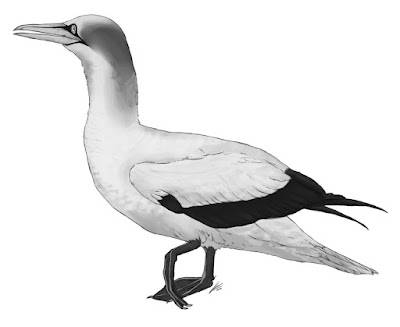 |
| reconstitution of the individual Morus sp. to which the coracoid CPGP.13.96.2 may have belonged in Figueiredo, Carvalho, Cachão & Fonseca, 2023. |
Abstract
The fossil remains of birds from the Miocene of Portugal are scarce, encompassing a total of twelve specimens, from nine paleontological outcrops located in Leiria (central Portugal), southern sector of Setúbal Peninsula and along the lower Tagus Basin. This study focuses on a new specimen found in the Praia do Penedo Norte (Sesimbra) coastal cliff corresponding to a coracoid bone, attributed to Morus sp., a sulid bird, biostratigraphically framed by calcareous nannofossils within the middle Miocene (Langhian).
Keywords: Langhian, Morus, Marine environment, Sesimbra
AVES Linnaeus 1758
SULIFORMES Sharpe 1891
SULIDAE Reichenbach 1849
MORUS Vieillot 1816
MORUS SP. Olson and Warheit 1988
Discussion and conclusion:
The broken part (see Fig. 6) of the processus acrocoracoideus do not seem to be the result of erosion resulting from postmortem transport, as this is one of the most resistant bone zones for erosion. The fact that it presents the same characteristics of similar traces in recent bones, resulting from gnawing, we think that this breakage was the result of the action of necrophagous animals. This necrophagy action may also have disassembled the skeleton.
The presence of seabirds in the Miocene of Praia do Penedo Norte is consistent with the fossil record of this paleontological site, where remains of marine vertebrates abound. The marine paleoenvironments over the continental shelf, as the calcareous nannofossils found in the sequence Praia do Penedo Norte indicate, are also in agreement with the environments frequented by birds of the genus Morus. The biostratigraphic calcareous nannofossil framework dates this specimen as Langhian (middle Miocene, 16–14 Ma).
The fossil coracoid now studied presents the main characteristics observed in coracoids of the genus Morus, as observed in the comparative study: pointed border of the cotyla scapularis, oval shape of the sacapularis cotyla, the narrow process acrocoracoid and the drop shaped facies articularis clavicularis.
Silvério Figueiredo, Carlos Neto de Carvalho, Mário Cachão and Alexandre Fonseca. 2023. A Marine Bird (Sulidae, Aves) from the Langhian (middle Miocene) of Penedo beach (Setúbal Peninsula—SW Portugal) and Its Paleoenvironmental Context. Journal of Iberian Geology. DOI: 10.1007/s41513-022-00203-5
Un ave marina (sulidae, Aves) del Langhiense (Mioceno medio) de la playa de Penedo (Península de Setúbal - SW Portugal) y su contexto paleoambiental
Resumen: Los restos fósiles de aves del Mioceno de Portugal son escasos, abarcando un total de doce especímenes, procedentes de nueve afloramientos paleontológicos distintos ubicados en Leiria (centro de Portugal), sector sur de la península de Setúbal y a lo largo de la cuenca baja del Tajo. Este estudio se centra en un nuevo ejemplar encontrado en el alcantilado costero de la Praia do Penedo Norte (Sesimbra) correspondiente a un hueso coracoides, atribuido a Morus sp., La bioestratigrafía, basada en nanofósiles calcáreos, remite el hallazgo al Mioceno medio (Langhiense).
Palabras clave: Langhiense, Morus, Ambiente marino, Sesimbra


